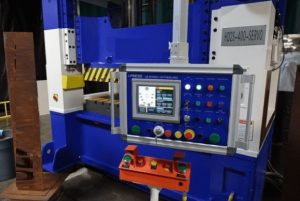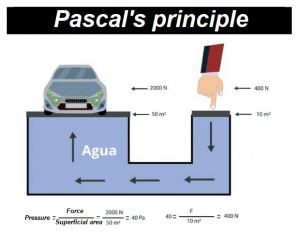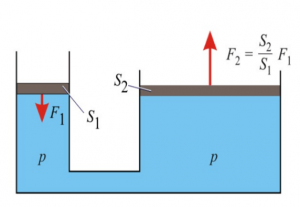Hydraulic press: what it is use for, how it works, examples
We explain the Hydraulic press, what it is use for, how it works, examples. The hydraulic press is a machine made up of pistons, which move in cylinders joined by communicating vessels filled with fluid, which acts to multiply the force. When a small force is applied to the inlet piston, the system offers a greater force to the outlet piston.
This greater force is used in the metalworking industry, to compress and cut metals, giving them the form of pieces or mechanical parts necessary to assemble cars, airplanes, electrical appliances and more.

It can also be used to lift heavy weights, exert traction, extract oil from seeds, and straighten deformed pieces of metal.
As they are almost always low maintenance and safe to use, hydraulic presses are a must in the industry. That is why they are manufactured in countless models and sizes, including smaller presses for domestic use.
Its operating principle is very simple, it is based on the so-called Pascal’s law . This states that the pressure applied to a fluid confined in a container is fully transmitted to each part of the fluid and the walls of the container. It is then that through the fluid, the applied force is transmitted and multiplied at the outlet.
History of the hydraulic press
Presses based on various mechanisms have been used since ancient times, to compress, laminate, cut and many more functions.
But the first hydraulic press, based on Pascal’s principle, is due to Joseph Bramah, an ingenious mechanic who was born in 1749 in the town of Stainborough, England. That is why the hydraulic press is also known as the Bramah press .
At first the Bramah press did not produce great forces. For this reason it was not suitable for minting coins or working metals on a large scale. But a short time later, in 1797, the brothers Jacques and Auguste Perier improved the design by reaching pressures greater than 70 kg / cm 2 .
A new optimization appeared in the mid-19th century, thanks to a Scottish machinist named John Haswell, who worked for the Austrian railways.
Since then, the hydraulic press became part of the tools in heavy industry to the present day, with much improved designs involving computerized control systems.
Pascal’s principle

This principle was discovered long before Bramah, in the 17th century, by the French scientist Blaise Pascal (1623 – 1662).
Pascal was a very prolific inventor during his short life. He became interested in mathematics, made important contributions to the theory of probabilities, and invented a mechanical calculator, called the pascaline .
Previously, at the hands of Pascal had come the experiments on vacuum and pressure, made by Evangelista Torricelli, assistant to the now elderly Galileo Galilei.
After much observation, he put his principle into practice by bursting a barrel full of water, adding just an additional 1 kg of water through a high-rise pipe.
Pascal managed to break the barrel thanks to the fact that water is not a very compressible liquid, that is, it does not change its volume easily. So if the water is confined and a small force is applied through a small piston, the pressure created, which is force divided by area, is large.
The force is thus transmitted to each molecule of the fluid and to the walls of the container equally.
If the container is tightly closed like the barrel, enough pressure will pop it. But if instead there is a moving piston at the other end, the force displaces it and can push or raise an object that is placed on it. This is how the hydraulic jack works.
Equations
In the following diagram you can see Pascal’s principle: a smaller force F 1 is applied to the small piston with area S 1 , thanks to which it produces a greater force F 2 , since it depends on the quotient (S 2 / S 1 ), which is greater than 1. Since the pressure is the same everywhere:
p = F 1 / S 1 = F 2 / S 2
From which it follows that the magnitude of the force transmitted to the largest piston is:
F 2 = (S 2 / S 1 ). F 1

What is the hydraulic press use for?
As we previously indicated, the hydraulic press has a variety of functions:
-Compress and pull.
-Cut pieces for a multitude of equipment.
-Laminate the metal.
-Squeeze fruits and seeds to extract the oil.
-Extract parts.
-Straighten deformed steel parts.
How does a hydraulic press work?
The hydraulic press works by applying a small input force, which will be amplified by the fluid to obtain a certain output force. This is achieved with the basic device described, in addition to several complementary systems.
The fluids used are diverse, usually derived from hydrocarbons and some presses contain more than one.
A modern hydraulic press is basically composed of:
– Hydraulic system , based on the Pascal principle described, which contains the hydraulic fluid, pistons, valves, filters, hoses and pipes, which complement the system. There are also pressure gauges to check the pressure and with it the output force.
Now, there are manual hydraulic presses such as hydraulic jacks for vehicles, but the most common in laboratories and industries is that they have a motor. Therefore several additional systems are also required:
– Electrical system , consisting of a starting system, wiring, coils, connectors and fuses.
– System power with a motor and pump.
– Computerized control system , contains the electronics necessary to operate the press according to job requirements.
Examples and applications
Compression and tensile tests
The properties of materials used in construction and manufacturing are tested by controlled trials.
With the help of the press, the samples are compressed or stretched little by little and the deformations they undergo are recorded. In this way it is known how much they resist before permanently deforming and breaking.
Manufacture body parts
A tool called a die is added to the press , which among other functions, allows cutting the metal sheets according to the design templates.
In this way the metal parts that make up the car body and other vehicles are cut.
In addition to being used to create body parts, the hydraulic press has other uses in the automotive industry, such as the assembly of various parts. That is why it is very useful in the mechanical workshop.
Compacting machines
A large amount of metal is found in end-of-life items, which can be reused, but must first be collected and stored.
Compaction machines reduce the volume of the metal, so it can be stored in smaller spaces while it is being used again. They can also reduce the volume of other waste materials for recycling, such as boxes and cartons.
In the food industry
There are hydraulic presses designed to process fruits and seeds, as well as oil extraction.
In the pharmaceutical industry
Medications come in numerous forms. The precisely sized and dosed tablets and tablets are manufactured using hydraulic presses that compact the compounds.
Presses are also used in the manufacture of compact powder shaped cosmetics.